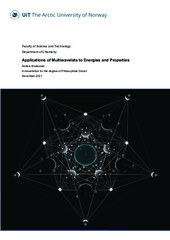| dc.contributor.advisor | Hopmann, Kathrin Helen | |
| dc.contributor.author | Brakestad, Anders | |
| dc.date.accessioned | 2022-02-01T07:16:15Z | |
| dc.date.available | 2022-02-01T07:16:15Z | |
| dc.date.issued | 2022-02-18 | |
| dc.description.abstract | The goal of quantum chemistry is to provide fast and accurate algorithms for the computation of molecular energies and properties. Over the years, a large number of methods have become available, and today computational chemists have a very rich toolbox of protocols that can be used to gain insight to chemistry. Gaussian type orbital (GTO) basis sets are at the core of most modern algorithms, and they have served the community well since they were first introduced. However, during the last 20 years, Multiwavelets (MWs) have emerged as a promising alternative to traditional GTO basis sets. Multiwavelets are built up from polynomial functions, and systematically approach completeness due to their robust mathematical foundation in multiresolution analysis.The in-house MW code MRChem has reached a level of maturity where it can be used to study chemical systems of 1000s of electrons. It provides functionality for the calculation of SCF energies, as well as electric and magnetic properties via density functional pertubation theory. This thesis presents the application of MWs in benchmark studies of static electric dipole polarizabilities (Paper I) and transition metal-ligand interaction energies (Paper II). Here we provide highly precise numerical results practically at the complete basis set limit, and with this reference we are able to quantify basis set incompleteness errors (BSIEs) in large GTO basis sets without ambiguity. The thesis also presents a prototype implementation of scalar relativistic effects via the zeroth order regular approximation into MRChem (Paper III, in preparation), and a preliminary quantification of BSIEs in several all-electron GTO basis sets for elements in the fifth row of the periodic table. | en_US |
| dc.description.doctoraltype | ph.d. | en_US |
| dc.description.popularabstract | Quantum chemistry as a field was born in the wake of the quantum revolution in the early 1900s, and its goal is to use the laws of quantum mechanics to develop tools that can answer relevant problems in chemistry. A quantum theory of chemistry becomes very complicated as soon as more than two particles are involved, and much of the research tries to come up with good approximations that are both fast and accurate. At the Hylleraas Centre for Quantum Molecular Sciences, a new type of quantum chemistry code has been developed during the last decade, that is able to provide more accurate results compared to conventional methods. In this thesis, I have been testing how good conventional methods are by comparing to our reference method. I have also been implementing algorithms based on Einstein's theory of special relativity, so that very heavy elements can be studied with more accuracy. Our data can be used to help other researchers in rational choice of computational protocols, and guide future development within quantum chemistry. | en_US |
| dc.identifier.isbn | 978-82-8236-468-3 (trykt) - 978-82-8236-469-0 (pdf) | |
| dc.identifier.uri | https://hdl.handle.net/10037/23861 | |
| dc.language.iso | eng | en_US |
| dc.publisher | UiT Norges arktiske universitet | en_US |
| dc.publisher | UiT The Arctic University of Norway | en_US |
| dc.relation.haspart | <p>Paper I: Brakestad, A., Jensen, S.R., Wind, P., D’Alessandro, M., Genovese, L., Hopmann, K.H. & Frediani, L. (2020). Static Polarizabilities at the Basis Set Limit: A Benchmark of 124 Species. <i>Journal of Chemical Theory and Computation, 16</i>(8), 4874–4882. Also available in Munin at <a href=https://hdl.handle.net/10037/18801>https://hdl.handle.net/10037/18801</a>.
<p>Paper II: Brakestad, A., Wind, P., Jensen, S.R., Frediani, L. & Hopmann, K.H. (2021). Multiwavelets applied to metal–ligand interactions: Energies free from basis set errors. <i>Journal of Chemical Physics, 154</i>(21), 214302. Also available in Munin at <a href=https://hdl.handle.net/10037/23657>https://hdl.handle.net/10037/23657</a>.
<p>Paper III: Brakestad, A., Jensen, S.R., Hopmann, K.H. & Frediani, L. Scalar relativistic effects with Multiwavelets: Implementation and benchmark. (Manuscript). | en_US |
| dc.rights.accessRights | openAccess | en_US |
| dc.rights.holder | Copyright 2022 The Author(s) | |
| dc.rights.uri | https://creativecommons.org/licenses/by-nc-sa/4.0 | en_US |
| dc.rights | Attribution-NonCommercial-ShareAlike 4.0 International (CC BY-NC-SA 4.0) | en_US |
| dc.subject | VDP::Matematikk og Naturvitenskap: 400::Kjemi: 440::Teoretisk kjemi, kvantekjemi: 444 | en_US |
| dc.subject | VDP::Mathematics and natural science: 400::Chemistry: 440::Theoretical chemistry, quantum chemistry: 444 | en_US |
| dc.title | Applications of Multiwavelets to Energies and Properties | en_US |
| dc.type | Doctoral thesis | en_US |
| dc.type | Doktorgradsavhandling | en_US |


 English
English norsk
norsk

